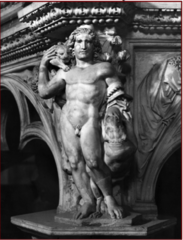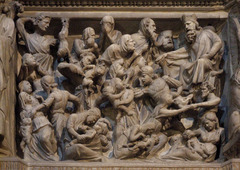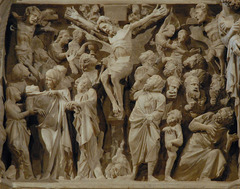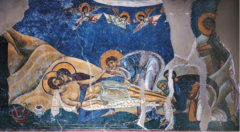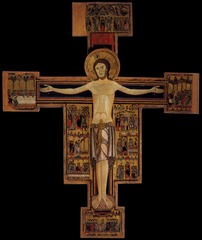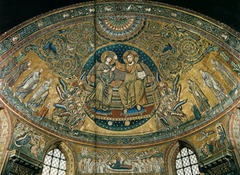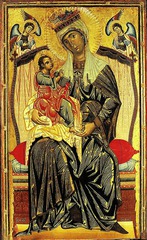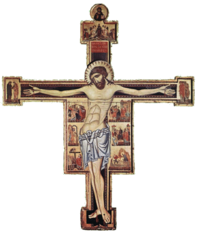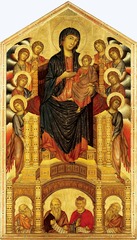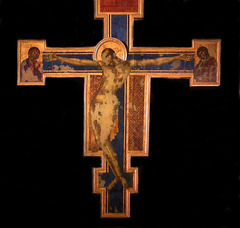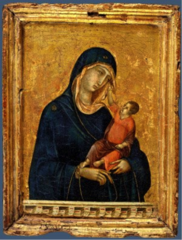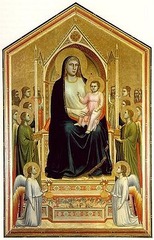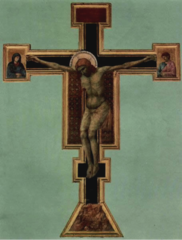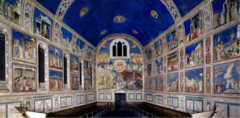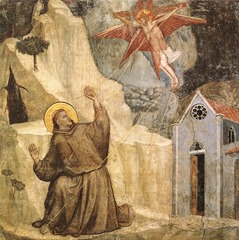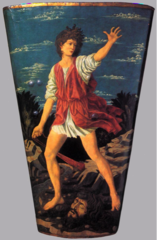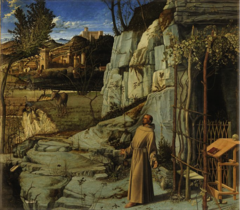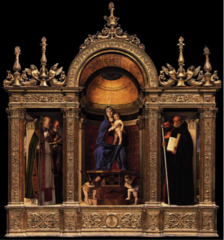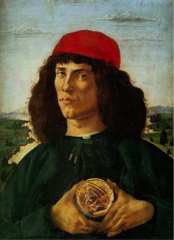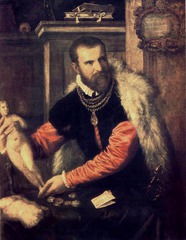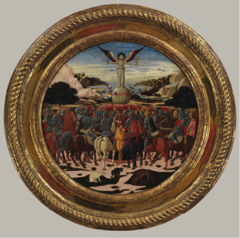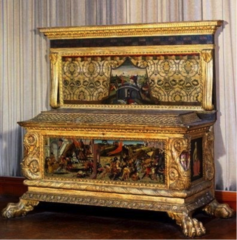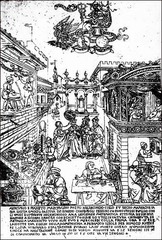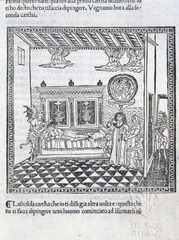duecento
the thirteenth (13th) century in Italian art. Literally the 1200s.
trecento
the 1300s, or fourteenth century, in Italian art
quattrocentro
The cultural and artistic events of 15th century Italy are collectively referred to as the Quattrocento.
tempera
A paint in which the pigments are mixed with egg yolk and water
mendicant order
Religious order that begs/depends on the charity of people for their livelihood. They do not own property, either individually or collectively, and try to copy the life of jesus. They spend their time preaching the Gospel and serving the poor (Franciscans, Dominicans, etc.)
stigmata
wounds which Christ received at the Crucifixion miraculously appear on the body of a saint
predella
the painted or sculpted lower portion of an altarpiece that relates to the subjects of the upper portion
cassone
Italian for “large case” or “large chest,” referring to carved and painted chests used to hold clothing, often given as gifts to a prospective bride for her dowry by her future husband. Many important paintings from the Renaissance were made to decorate these chests and other items of furniture.
desco da parto
“Birth trays”
– Related in ways to Birth of the Virgin altarpiece – Trays would be brought into women who were bedridden for a certain amount of time around giving birth
-Often commissioned by husbands and family
– Mundane, religious, mythological, etc. subjects
– Triumph of Fame, 1448-49
-Piero de’Medici presented to wife for birth of first son (Lorenzo)
-Lorenzo had it hanging on his wall when he died
guild
A medieval organization of crafts workers or trades people.
confraternity
a lay brotherhood devoted to some purpose, esp. to religious or charitable service
reliquary
a container where religious relics are stored or displayed (especially relics of saints)
sarcophagus
an ancient marble or stone coffin, often decorated with artwork and inscriptions
tympanum
half-round panel that fills the space between the lintle and arch over the doorway of the church.
trumeau
in church architecture, the pillar or center post supporting the lintel in the middle of the doorway.
Palmesel
German word for “palm donkey” referring to a statue of Christ on a donkey
maniera greca
“greek style” of the 13th century that demonstrated both Italian and Byzantine influences. Frontality, lack of modeling (flat forms), extensive use of gold leaf. Madonna enthroned with Angels and Prophets-Cimabue
tramezzo
a screen placed across the nave of a church to separate the clergy from the lay audience
chrysography
Literally, “gold-writing;” a Greek-derived term that describes the pattern of gold lines used in Byzantine, and Italo-Byzantine art to suggest the highlighted ridges of drapery folds.
buon fresco
true or wet fresco; pigments are mixed with water and become chemically bound to the freshly laid lime plaster
fresco seco
fresco painting technique in which watercolors are applied to dry plaster that has been moistened to simulate fresh plaster
Christus triumphans
Latin for triumphant Christ; a cross with a representation of a living Christ, eyes open and triumphant over death
Christus patiens
Latin phrase for suffering Christ. A cross with a representation of the dead Christ
ingegno
italian, “innate talent”
one of several terms used in italian renaissance literature to praise the originality and talent of artists
Hippolytus and Phaedra, Roman sarcophagus, marble, 2nd c. AD (Camposanto, Pisa), marble
Annunciation, The Nativity, and the Annunciation to the Shepherds, Nicola Pisano, 1260, panel from pulpit in Pisa Baptistry, marble
Daniel/Fortitude, Nicola Pisano, 1260, capital of pulpit in Pisa Cathedral Baptistry
Annunciation and The Nativity, Giovanni Pisano, 1297-1301, panel from from pulpit of Sant’Andrea, Pistoia, marble
Massacre of the Innocents, Giovanni Pisano, 1297-1301, panel from the pulpit of Sant’Andrea, Pistoaia, marble
Cruxifixion, Giovanni Pisano, 1297-1301, panel from pulpit of Sant’Andrea, Pistoia, marble
Sibyl, Giovanni Pisano, 1297-1301, attached to column from pulpit of Sant’Andrea, Pistoia, marble
Lamentation, Byzantine Master, 1164, fresco, St. Pantaleimon, Macedonia
Christ on the Cross, Pisan/Florentine School, late 12th-early 13th c., tempera on panel
Altarpiece of St. Francis, Bonaventura Berlinghieri, 1235, S. Francesco, Pescia, tempera on panel
Coronation of the Virgin, Jacopo Torriti, 1295, apse of S.M. Maggiore, Rome, mosaic
Section of Last Judgement, Pietro Cavallini, 1293, Santa Cecilia in Trastevere, Rome, fresco
Birth of the Virgin, Pietro Cavallini, late 1290s, Transept wall of S.M. Maggiore in Trastevere, Rome, mosaic
Madonna and Child, Coppo di Marcovaldo, 1265, S. Martino dei Servi, Orvieto, tempera on panel
Crucifix, Coppo di Marcovaldo, second half of 13th c., Pinacoteca, S. Gimignano, tempera on panel
S. Trinita Altarpiece (Madonna and Child with Angels and Prophets), 1280, tempera on panel
Crucifix, Cimabue, 1280s, S. Croce, Florence, tempera on panel (before damage)
Cruxix, Cimabue, 1280s, S. Croce (after damage)
Madonna and Child (“Stroganoff Madonna”), Duccio di Buoninsegna, 1295-1300, tempera on panel
Ognissanti Altarpiece, Giotto, 1305-10, tempera on panel
Crucifix, Giotto, 1295-1300, S. Maria Novella, Florence, tempera on panel
Fresco Cycle in Arena Chapel (Capella Scrovegni), Giotto Padua, 1303-4
St. Francis Receiving the Stigmata, Giotto, 1320s, Bardi Chapel, S. Croce, Florence, fresco
Triumph of David, Andrea del Castagno, 1450, shield, leather on wood
St. Francis in the Desert, Bellini, 1480, oil and tempera on canvas
Madonna dei Frari, Bellini, 1488, S. Maria dei Frari, Venice, oil on panel
Portrait of a Man Holding a Medallion with Cosimo il Vecchio de’Medici, Botticelli, 1475, tempera and oil on panel
Venus of Urbino, Titian, 1538, oil on canvas
Portrait of Jacopo Strada, Titian, 1567-8, oil on canvas
Triumph of Fame, Lo Scheggia, 1449, desco da parto celebrating the birth of Lorenzo de’Medici, tempera on panel
Cassone made for Morelli-Nerli wedding in 1472, Jacopo del Sallaio and Biagio d’Antonio, tempera on wood with gold leaf
The Planet Mercury and the Professions Practiced under His Sign, Baccio Baldini, 1464-65,
Woodcut illustration from Predica dell’arte del bene morire (Sermon on the art of dying well), by Girolamo Savonarola, 1495


